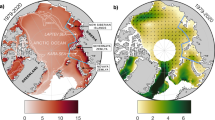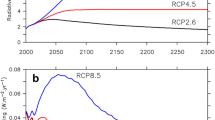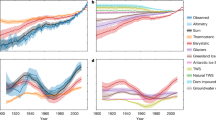Abstract
We propose linear response functions to separately estimate the sea-level contributions of thermal expansion and solid ice discharge from Greenland and Antarctica. The response function formalism introduces a time-dependence which allows for future rates of sea-level rise to be influenced by past climate variations. We find that this time-dependence is of the same functional type, R(t) ∼ t α, for each of the three subsystems considered here. The validity of the approach is assessed by comparing the sea-level estimates obtained via the response functions to projections from comprehensive models. The pure vertical diffusion case in one dimension, corresponding to α = −0.5, is a valid approximation for thermal expansion within the ocean up to the middle of the twenty first century for all Representative Concentration Pathways. The approximation is significantly improved for α = − 0.7. For the solid ice discharge from Greenland we find an optimal value of α = −0.7. Different from earlier studies we conclude that solid ice discharge from Greenland due to dynamic thinning is bounded by 0.42 m sea-level equivalent. Ice discharge induced by surface warming on Antarctica is best captured by a positive value of α = 0.1 which reflects the fact that ice loss increases with the cumulative amount of heat available for softening the ice in our model.








Similar content being viewed by others
References
Allen MR, Frame DJ, Huntingford C, Jones CD, Lowe JA, Meinshausen M, Meinshausen N (2009) Warming caused by cumulative carbon emissions towards the trillionth tonne. Nature 458:1163–1166. doi:10.1038/nature08019
Bueler E, Brown J (2009) The shallow shelf approximation as a sliding law in a thermomechanically coupled ice sheet model. J Geophys Res 114:F03008
Church J, Gregory J, Huybrechts P, Kuhn M, Lambeck K, Nhuan M, Qin D, Woodworth P (2001) Changes in sea level. In: Houghton J, Ding Y, Griggs D, Noguer M, Linden PV, Dai X, Maskell K, Johnson C (eds) Climate change 2001: the scientific basis: contribution of working group I to the third assessment report of the intergovernmental panel on climate change. Cambridge University Press, Cambridge, pp 639–694
Church JA, White NJ, Konikow LF, Domingues CM, Cogley JG, Rignot E, Gregory JM, van den Broeke MR, Monaghan AJ, Velicogna I (2011) Revisiting the Earth’s sea-level and energy budgets from 1961 to 2008. Geophys Res Lett 38:L18601. doi:10.1029/2011GL048794
Frieler K, Meinshausen M, Mengel M, Braun N, Hare W (2011) A scaling approach to probabilistic assessment of regional climate change. J Clim. doi:10.1126/science.1070942
Gillett NP, Arora VK, Zickfeld K, Marshall SJ, Merryfield WJ (2011) Ongoing climate change following a complete cessation of carbon dioxide emissions. Nat Geosci 4:83–87. doi:10.1038/ngeo1047
Good P, Gregory JM, Lowe JA (2011) A step-response simple climate model to reconstruct and interpret AOGCM projections. Geophys Res Lett 38:L01703. doi:10.1029/2010GL045208
Hansen J, Ruedy R, Sato M, Imhoff M, Lawrence W, Easterling D, Peterson T, Karl T (2001) A closer look at United States and global surface temperature change. J Geophys Res 106:23947–23964. doi:10.1029/2001JD000354
Hooss G, Voss R, Hasselmann K, Maier-Reimer E, Joos F (2001) A nonlinear impulse response model of the coupled carbon cycle-climate system (NICCS). Clim Dyn 18:189–202. doi:10.1007/s003820100170
Huybrechts P, Goelzer H, Janssens I, Driesschaert E, Fichefet T, Goosse H, Loutre MF (2011) Response of the Greenland and Antarctic ice sheets to multi-millennial greenhouse warming in the earth system model of intermediate complexity LOVECLIM. Surv Geophys 32:397–416
Jevrejeva S, Moore JC, Grinsted A (2010) How will sea level respond to changes in natural and anthropogenic forcings by 2100? Geophys Res Lett 37:7703. doi:10.1029/2010GL042947
Martin MA, Winkelmann R, Haseloff M, Albrecht T, Bueler E, Khroulev C, Levermann A (2011) The Potsdam Parallel Ice Sheet Model (PISM-PIK) part 2: dynamic equilibrium simulation of the Antarctic ice sheet. The Cryosphere 5(3):727–740
Marčelja S (2010) The timescale and extent of thermal expansion of the global ocean due to climate change. Ocean Sci 6:179–184
Meier MF, Dyurgerov MB, Rick UK, ÓNeel S, Pfeffer WT, Anderson RS, Anderson SP, Glazovsky AF (2007) Glaciers dominate eustatic sea-level rise in the 21st century. Science 317:1064–1067. doi:10.1126/science.1143906
Meinshausen M, Smith S, Calvin K, Daniel J, Kainuma M, Lamarque JF, Matsumoto K, Montzka S, Raper S, Riahi K, Thomson A, Velders G, van Vuuren D (2011) The RCP greenhouse gas concentrations and their extensions from 1765 to 2300. Clim Chang 109:213–241. doi:10.1007/s10584-011-0156-z
Mikolajewicz U, Gröger M, Maier-Reimer E, Schurgers G, Vizcaíno M, Winguth AME (2007) Long-term effects of anthropogenic CO2 emissions simulated with a complex earth system model. Clim Dyn 28:599–633. doi:10.1007/s00382-006-0204-y
Montoya M, Griesel A, Levermann A, Mignot J, Hofmann M, Ganopolski A, Rahmstorf S (2005) The earth system model of intermediate complexity CLIM BER-3α. Part I: description and performance for present day conditions. Clim Dyn 25:237–263
Pfeffer WT, Harper JT, O’Neel S (2008) Kinematic constraints on glacier contributions to 21st-century sea-level rise. Science 321:1340–1343
Price SF, Payne AJ, Howat IM, Smith BE (2011) Committed sea-level rise for the next century from Greenland ice sheet dynamics during the past decade. Proc Natl Acad Sci 108:8978–8983
Rahmstorf S (2007) A semi-empirical approach to projecting future sea-level rise. Science 315:368–370
Riahi K, Grübler A, Nakicenovic N (2007) Scenarios of long-term socio-economic and environmental development under climate stabilization. Technol Forecast Soc Chang 74(7):887–935. doi:10.1016/j.techfore.2006.05.026
Ridley J, Gregory JM, Huybrechts P, Lowe JA (2010) Thresholds for irreversible decline of the greenland ice sheet. Clim Dyn 35:1049–1057. doi:10.1007/s00382-009-0646-0
Schewe J, Levermann A, Meinshausen M (2011) Climate change under a scenario near 1.5°C of global warming: monsoon intensification, ocean warming and steric sea level rise. Earth Syst Dyn 2(1):25–35. doi:10.5194/esd-2-25-2011
Solomon S, Plattner GK, Knutti R, Friedlingstein P (2009) Irreversible climate change due to carbon dioxide emissions. Proc Natl Acad Sci 106:1704–1709. doi:10.1073/pnas.0812721106
Swingedouw D, Fichefet T, Hybrechts P, Goosse H, Driesschaert E, Loutre MF (2008) Antarctic ice-sheet melting provides negative feedbacks on future climate warming. Geophys Res Lett 35:doi:10.1029/2008GL034,410
Vermeer M, Rahmstorf S (2009) Global sea level linked to global temperature. Proc Natl Acad Sci 106:21527–21532
Vizcaino M, Mikolajewicz U, Jungclaus J, Schurgers G (2010) Climate modification by future ice sheet changes and consequences for ice sheet mass balance. Clim Dyn 34:301–324
van Vuuren DP, Eickhout B, Lucas PL, den Elzen MGJ (2006) Long-term multi-gas scenarios to stabilise radiative forcing—exploring costs and benefits within an integrated assessment framework. The energy journal 27:201–233
van Vuuren D, den Elzen M, Lucas P, Eickhout B, Strengers B, van Ruijven B, Wonink S, van Houdt R (2007) Stabilizing greenhouse gas concentrations at low levels: an assessment of reduction strategies and costs. Clim Chang 159:81–119
Winguth A, Mikolajewicz U, Gröger M, Maier-Reimer E, Schurgers G, Vizcaíno M (2005) Centennial-scale interactions between the carbon cycle and anthropogenic climate change using a dynamic Earth system model. Geophys Res Lett 32:L23,714
Winkelmann R, Martin MA, Haseloff M, Albrecht T, Bueler E, Khroulev C, Levermann A (2011) The Potsdam Parallel Ice Sheet Model (PISM-PIK) part 1: model description. The Cryosphere 5(3):715–726. doi:10.5194/tc-5-715-2011
Winkelmann R, Levermann A, Frieler K, Martin MA (2012) Uncertainty in future solid ice discharge from Antarctica. The Cryosphere Discuss 6:673–714. doi:10.5194/tcd-6-673-2012
Acknowledgments
This study was funded by the German Federal Ministry of Education and Research (BMBF). We would like to thank Stephen Price for sharing his data with us.
Author information
Authors and Affiliations
Corresponding author
Rights and permissions
About this article
Cite this article
Winkelmann, R., Levermann, A. Linear response functions to project contributions to future sea level. Clim Dyn 40, 2579–2588 (2013). https://doi.org/10.1007/s00382-012-1471-4
Received:
Accepted:
Published:
Issue Date:
DOI: https://doi.org/10.1007/s00382-012-1471-4




